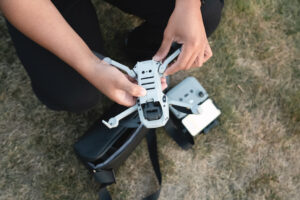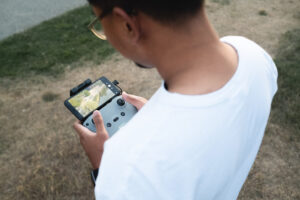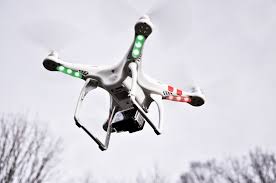Key Takeaways
-
Using a VR headset for drone control can significantly enhance your flying experience, offering a first-person view and precise control.
-
Setting up your VR drone system involves pairing the headset with the drone, calibrating the system, and performing pre-flight checks.
-
When flying with a VR headset, it’s essential to understand the interface, navigate effectively, and master advanced maneuvers for a superior flight experience.
-
VR headset drone control opens up new possibilities for applications such as drone racing and exploring scenic vistas from a bird’s-eye view.
-
Ensuring safety and responsible piloting is crucial when flying drones with VR headsets, especially in shared airspaces.

To achieve a precision virtual reality flying experience with a drone
You can consider using the DJI FPV Combo with DJI FPV Goggles V2, which is known for its immersive flight and robust features1
This VR drone offers a 4K HD video with super-wide angle capabilities, a 6.2 miles range, and a flight time of 20 minutes. Additionally, the DJI Avata is another excellent option for an immersive VR drone experience, featuring a 48 MP camera and a range of 11.6 km1
For those looking for a pro-level VR drone, the DJI Mavic 3 Classic stands out with its 4/3 CMOS Hasselblad Camera, offering up to 15 km range and an impressive flight time of 46 minutes1
Moreover, to practice flying your drone in VR before taking off with your real drone, you can utilize DJI’s Virtual Flight app2
This app allows you to simulate accurate drone flight characteristics and provides a safe environment for practice. It connects to your drone’s controller and headset to create a realistic flying experience similar to VR. The app is compatible with various devices like Windows PCs, Android phones, iPhones, and iPads2
In summary, for a precision virtual reality flying experience with a drone, consider using top VR drones like the DJI FPV Combo or DJI Avata and practice safely using DJI’s Virtual Flight app to enhance your skills before actual flights12
Soar to New Heights: Mastering VR Headset Drone Control
Have you ever wondered what it’s like to fly? Not just to pilot a drone from the ground, but to soar through the skies as if you were on board? That’s the magic of using a VR headset for drone control. It’s not just about the thrill; it’s about precision, about truly connecting with your drone, and seeing the world from a whole new perspective.
Fly Like a Pro with Precision VR Controls
Imagine donning a headset and being transported into the cockpit of your drone. You’re no longer a distant observer; you’re in command, with every tilt and turn at your fingertips. The VR headset doesn’t just provide a view—it’s a gateway to an intuitive and precise flying experience.
The Sky’s the Limit with Virtual Reality Flight
And the best part? The sky’s the limit. Whether you’re racing between obstacles or gently gliding over landscapes, VR headsets take drone flying to new heights—literally and figuratively. So let’s dive into how you can master this technology and make every flight an adventure.
Core Components of VR Headset Drone Flying
Understanding Your VR Headset Interface
Before you take off, you need to get familiar with your VR headset. It’s your control center, your eyes in the sky. Most importantly, it should be comfortable and provide a clear, lag-free view of your drone’s camera feed. The interface will typically display essential flight data like battery life, signal strength, and GPS information. Take time to learn the layout, so you can keep your focus on flying, not fumbling with controls.
Selecting the Right Drone for VR Flight
Not all drones are created equal, especially when it comes to VR capabilities. You’ll want a drone that’s VR-ready, with a camera capable of streaming high-quality video and responsive controls for smooth navigation. Here are a few key features to look for:
-
Stable flight characteristics for a smoother VR experience.
-
A high-definition camera to get the most out of your VR headset’s display.
-
Low latency video transmission to ensure real-time responsiveness.
Once you’ve chosen the right drone, it’s time to pair it with your VR headset and get ready for takeoff.

Using a VR headset for drone control offers several benefits
Enhancing the overall flying experience and opening up new possibilities across various industries. Here are some key advantages highlighted in the search results:
-
Immersive Experience: VR headsets provide a more immersive flying experience by allowing users to see exactly what the drone sees in real-time, creating a sense of being in the drone itself1
-
Convenience and Efficiency: Controlling a drone with a VR headset enables users to move the drone camera simply by turning their head, offering a convenient way to capture footage from different angles without manually repositioning the drone2
-
Enhanced Control Environment: VR goggles used for drone control can provide a more realistic environment by incorporating sensory elements beyond just visual information. For example, users can feel wind sensations and hear sounds through bone conduction earphones, enhancing the overall control immersion3
-
Industry Applications: The combination of VR and UAVs (drones) is revolutionizing various industries like agriculture, construction, engineering, and real estate. In these sectors, VR-controlled drones are used for inspections, monitoring construction progress, safety inspections, analyzing surroundings, property tours, and optimizing space usage2
-
Innovative Technology: Companies like DJI, Intel, Samsung, Oculus, Yuneec, and Zeiss are actively developing state-of-the-art VR-compatible drones and FPV goggles to enhance the user experience and explore new applications of this technology25
In summary, using a VR headset for drone control not only enhances the flying experience but also offers practical benefits across different industries by providing a more immersive and efficient way to operate drones123

Setting Up Your VR Drone System
Pairing the Headset with the Drone
Pairing your VR headset with your drone is the first step to an immersive flight experience. This usually involves connecting the headset to your drone’s camera system via an app or directly through a compatible receiver. Make sure your headset is fully charged, and follow the manufacturer’s instructions to establish a secure connection.
Calibration and Pre-Flight Checks
Calibration is crucial. It ensures that your VR headset and drone are in perfect sync. Most drones come with a calibration process that you can initiate through their companion app. It’s also wise to do a pre-flight check every time you fly:
-
Ensure all firmware is up to date to avoid technical hiccups.
-
Check the drone’s battery level and the condition of its propellers.
-
Inspect the VR headset’s display and controls for functionality.
With your system calibrated and pre-flight checks complete, you’re almost ready to take to the skies.

Applications and Adventures in VR Drone Flight
When you merge the world of drones with the immersive power of VR, the applications and adventures are boundless. From competitive racing to serene aerial tours, VR headset drone control isn’t just about the technology—it’s about the experiences it unlocks.
Drone Racing: The Virtual Track
Drone racing has evolved from a niche hobby to a full-blown competitive sport, and VR headsets are taking it to the next level. Pilots navigate complex courses at high speeds, all from the drone’s perspective, making for an adrenaline-pumping experience that’s as close to flying as it gets.
Racing drones are specially designed for speed and agility, and when paired with a VR headset, the pilot’s reaction times can improve dramatically. You’ll feel every twist and turn, with the headset’s display mirroring your drone’s agile maneuvers. This isn’t just flying; it’s competing with the birds.
Exploring Scenery from a Bird’s-Eye View
But it’s not all about the thrill of the race. Sometimes, the most profound joy comes from a peaceful flight over stunning landscapes. Imagine soaring over mountains, rivers, and cities, all from the comfort of your backyard. With VR headset drone control, you can embark on scenic flights that were once the domain of birds and aircraft.
The immersive view allows you to appreciate the beauty of nature or urban architecture in a way that traditional drone flying can’t match. It’s a blend of technology and artistry that can inspire photographers, videographers, and explorers alike.
Improving Your Flight Skills with VR Training
One of the greatest advantages of VR headset drone control is the ability to train and improve your flying skills in a risk-free environment. Simulation software can mimic real-world physics, providing a safe space to practice maneuvers and hone your piloting abilities.
From Simulation to Real-World Flying
Starting with simulations means you can push your drone—and your skills—to the limit without fear of a costly crash. It’s an excellent way for beginners to get comfortable with the controls and for seasoned pilots to try out new techniques. Once you’ve mastered the virtual controls, transitioning to real-world flying becomes a breeze.
Training with a VR headset also means you can fly in all kinds of virtual conditions. You can simulate wind, rain, or even mechanical failures to ensure you’re ready for anything when you take to the skies for real.
Tracking Your Progress with VR Analytics
With VR training, you’re not just flying blind. Advanced analytics can track your progress, providing insights into your reaction times, accuracy, and decision-making. These metrics are invaluable for refining your skills and pushing your piloting to new heights.
For example, after a session of VR training, you might review your analytics and notice that your turns are sharper and your reaction to obstacles is quicker. This feedback loop is what turns good pilots into great ones.
And as you track your improvement, you’ll find that your confidence in controlling the drone in real-life situations has significantly increased.

Ensuring Safety in the Virtual Skies
With all this talk of high-speed racing and immersive exploration, it’s essential to touch on safety. Flying a drone, especially with a VR headset, comes with responsibilities—to yourself, others, and the airspace you’re sharing.
Understanding and Mitigating Risks
Before you even power up your drone, be aware of the risks. Know the laws and regulations that apply to your area, and always perform a safety check on your equipment. Besides that, be mindful of your surroundings—avoid flying near airports, crowds, or in adverse weather conditions.
Responsible VR Drone Piloting
Being a responsible pilot also means knowing your limits. Start slow, get to know your drone’s capabilities, and don’t push beyond what you can safely control. Remember, the VR headset is there to enhance your experience, not to lead you into hazardous situations.
The Future of Flight: Innovations in VR Drone Technology
As VR technology continues to advance, so too does its application in drone control. We’re on the cusp of a new era of flight, with innovations that promise to make the experience even more immersive and intuitive.
Upcoming Features in VR Drone Control
Looking ahead, we can expect VR headsets to offer even more realistic experiences, with better resolution, wider field of view, and more seamless integration with drone controls. Here are a few developments on the horizon:
-
Gesture-based controls that allow for more natural and intuitive piloting.
-
Haptic feedback that gives you a physical sensation of the drone’s movement.
-
Augmented reality overlays that provide real-time data and navigation aids.
These features will not only enhance the fun of flying but will also improve safety and precision.
Industry Trends and New Horizons
The drone industry is rapidly evolving, with VR at the forefront of this transformation. We’re seeing a surge in interest from sectors such as real estate, agriculture, and search and rescue, all looking to leverage the power of VR-enhanced drones.
Step-Up Your Game: Equipment and Accessory Guide
Now that you’re familiar with the possibilities of VR headset drone control, let’s make sure you have the right gear. A solid setup not only improves your flying experience but also ensures you can fly with confidence and safety.
Essential Accessories for VR Drone Piloting
To get the most out of your VR drone piloting experience, you’ll want to invest in some key accessories:
-
A reliable and fast microSD card to record your flights without interruption.
-
Extra batteries to extend your flight sessions and reduce downtime.
-
A carrying case to protect your VR headset and drone during transport.
-
Propeller guards to minimize damage during close encounters or crashes.
-
An anti-glare screen protector for your headset to maintain clear visibility even in bright conditions.
Maintaining Your Equipment for Longevity
Looking after your drone and VR headset is crucial for ensuring they both have a long and productive life. Regularly clean your equipment, checking for any signs of wear and tear. Store your drone and headset in a cool, dry place, away from direct sunlight. And always follow the manufacturer’s guidelines for updates and maintenance.

Flying High and Landing Smoothly
Knowing how to start your flight is important, but knowing how to end it is just as crucial. Always have a landing plan in place. Monitor your drone’s battery level carefully, and begin your descent well before it gets too low. When you’re ready to land, choose a clear, flat area away from people and obstacles, and bring your drone down slowly and steadily.
Knowing When and How to Conclude Your Flight Session
Concluding your flight session is about more than just landing safely. It’s about reviewing your flight data, learning from your experience, and preparing for the next adventure. Check the footage from your flight, analyze any issues that arose, and make a note of them for next time. Charge your batteries, back up your data, and get ready to fly again.
Frequently Asked Questions (FAQ)
As you delve into the world of VR headset drone control, you’re bound to have questions. Here are some answers to the most common queries:
Can VR Headset Drone Control Improve Flight Precision?
Yes, using a VR headset can significantly improve your flight precision. The first-person view allows for more accurate navigation and control, especially when flying in tight spaces or performing complex maneuvers.
For example, pilots using VR headsets for drone racing often report faster lap times and fewer crashes due to the increased precision and immersion provided by the VR experience.
How Does VR Headset Affect Battery Life During a Drone Flight?
While a VR headset itself doesn’t consume power from the drone’s battery, it’s important to note that flying in VR can sometimes lead to longer flight times as pilots are more engaged. Therefore, it’s always a good idea to have extra batteries on hand to ensure you can enjoy extended VR flying sessions.
Is Drone Racing with VR Headsets Safe for Beginners?
Drone racing with VR headsets can be safe for beginners, provided they take the time to learn and practice in a controlled environment. It’s also important to start with a beginner-friendly drone and to use propeller guards and other safety features until you’re more confident in your skills.
What Types of Drones Are Compatible with VR Headsets?
Many modern drones are compatible with VR headsets, particularly those designed for FPV (First Person View) flying. Drones from brands like DJI, Parrot, and Yuneec offer models that are either VR-ready out of the box or can be easily adapted for VR use.
-
DJI models such as the Phantom, Mavic, and FPV series are known for their VR capabilities.
-
Parrot’s Anafi and Bebop drones offer immersive FPV experiences with VR headsets.
-
Yuneec drones like the Typhoon series also support VR features.
Can You Use VR Drone Control in Restricted Airspaces?
It’s crucial to understand that the use of VR headset drone control doesn’t exempt you from following local drone laws and regulations. Restricted airspaces are off-limits for drone flying, with or without VR. Always check your local regulations before flying, and use apps or tools provided by aviation authorities to ensure you’re flying legally and safely. For more information on drone safety gear, consider reading about the Fat Shark HDO3 drone racing goggles.
In conclusion, VR headset drone control is an exciting advancement in the world of drones, offering pilots an unparalleled flying experience. By understanding the technology, selecting the right equipment, and flying responsibly, you can take your drone adventures to incredible new heights. So strap on your VR headset, power up your drone, and get ready to experience flight like never before.
For those looking to dive into the world of FPV drone racing, understanding the basics of drone dynamics and performance is crucial. Whether you’re interested in building your own FPV racing drone or selecting a ready-to-fly kit, it’s important to have a good grasp of the components and technology that make these drones soar. From choosing the right flight controller to mastering the nuances of drone piloting, every detail matters in the competitive arena of drone racing. For enthusiasts eager to learn more, a comprehensive guide to building your own FPV racing drone can provide valuable insights and tips to get started on this thrilling journey.


